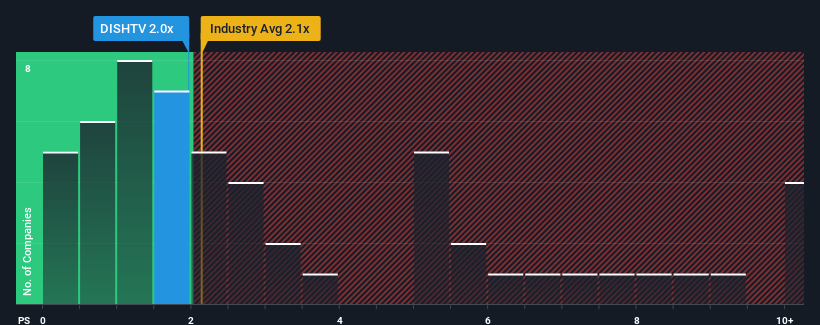Many Still Looking Away From Dish TV India Limited (NSE:DISHTV)
With a median price-to-sales (or "P/S") ratio of close to 2.1x in the Media industry in India, you could be forgiven for feeling indifferent about Dish TV India Limited's (NSE:DISHTV) P/S ratio of 2x. While this might not raise any eyebrows, if the P/S ratio is not justified investors could be missing out on a potential opportunity or ignoring looming disappointment.
See our latest analysis for Dish TV India

What Does Dish TV India's P/S Mean For Shareholders?
Dish TV India could be doing better as its revenue has been going backwards lately while most other companies have been seeing positive revenue growth. It might be that many expect the dour revenue performance to strengthen positively, which has kept the P/S from falling. If not, then existing shareholders may be a little nervous about the viability of the share price.
Keen to find out how analysts think Dish TV India's future stacks up against the industry? In that case, our free report is a great place to start.Is There Some Revenue Growth Forecasted For Dish TV India?
In order to justify its P/S ratio, Dish TV India would need to produce growth that's similar to the industry.
Taking a look back first, the company's revenue growth last year wasn't something to get excited about as it posted a disappointing decline of 20%. This means it has also seen a slide in revenue over the longer-term as revenue is down 40% in total over the last three years. Therefore, it's fair to say the revenue growth recently has been undesirable for the company.
Shifting to the future, estimates from the only analyst covering the company suggest revenue should grow by 24% over the next year. Meanwhile, the rest of the industry is forecast to only expand by 12%, which is noticeably less attractive.
In light of this, it's curious that Dish TV India's P/S sits in line with the majority of other companies. It may be that most investors aren't convinced the company can achieve future growth expectations.
The Bottom Line On Dish TV India's P/S
While the price-to-sales ratio shouldn't be the defining factor in whether you buy a stock or not, it's quite a capable barometer of revenue expectations.
Looking at Dish TV India's analyst forecasts revealed that its superior revenue outlook isn't giving the boost to its P/S that we would've expected. Perhaps uncertainty in the revenue forecasts are what's keeping the P/S ratio consistent with the rest of the industry. This uncertainty seems to be reflected in the share price which, while stable, could be higher given the revenue forecasts.
You should always think about risks. Case in point, we've spotted 2 warning signs for Dish TV India you should be aware of.
Of course, profitable companies with a history of great earnings growth are generally safer bets. So you may wish to see this free collection of other companies that have reasonable P/E ratios and have grown earnings strongly.
New: Manage All Your Stock Portfolios in One Place
We've created the ultimate portfolio companion for stock investors, and it's free.
• Connect an unlimited number of Portfolios and see your total in one currency
• Be alerted to new Warning Signs or Risks via email or mobile
• Track the Fair Value of your stocks
Have feedback on this article? Concerned about the content? Get in touch with us directly. Alternatively, email editorial-team (at) simplywallst.com.
This article by Simply Wall St is general in nature. We provide commentary based on historical data and analyst forecasts only using an unbiased methodology and our articles are not intended to be financial advice. It does not constitute a recommendation to buy or sell any stock, and does not take account of your objectives, or your financial situation. We aim to bring you long-term focused analysis driven by fundamental data. Note that our analysis may not factor in the latest price-sensitive company announcements or qualitative material. Simply Wall St has no position in any stocks mentioned.
About NSEI:DISHTV
Dish TV India
Provides direct to home (DTH) television and teleport services in India.
Undervalued with reasonable growth potential.
Similar Companies
Market Insights
Community Narratives




